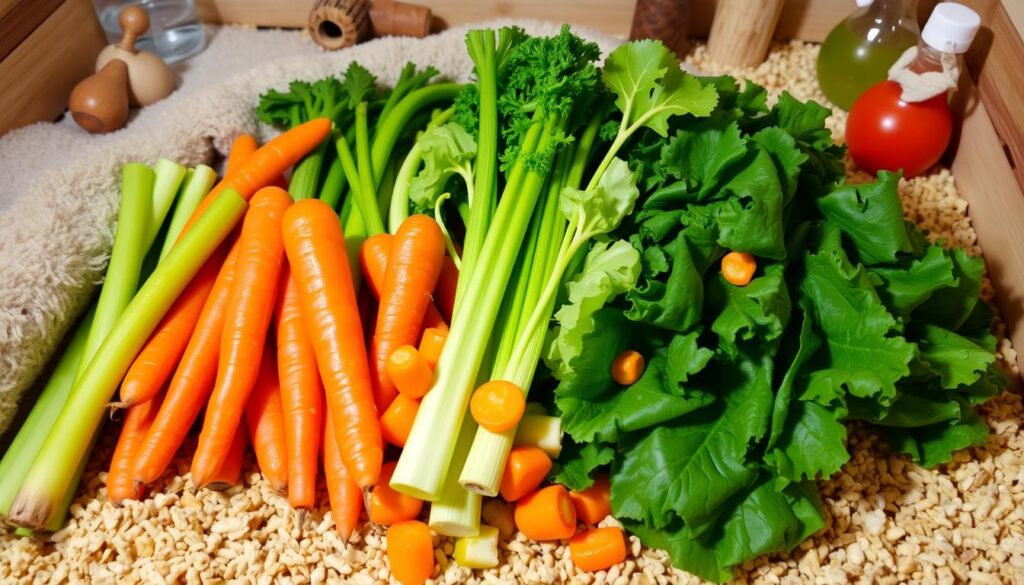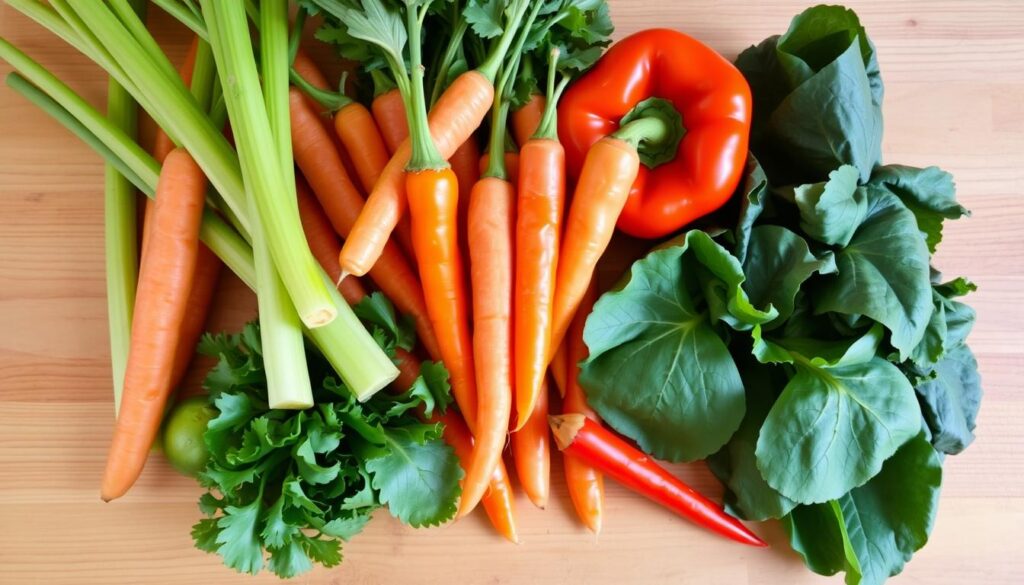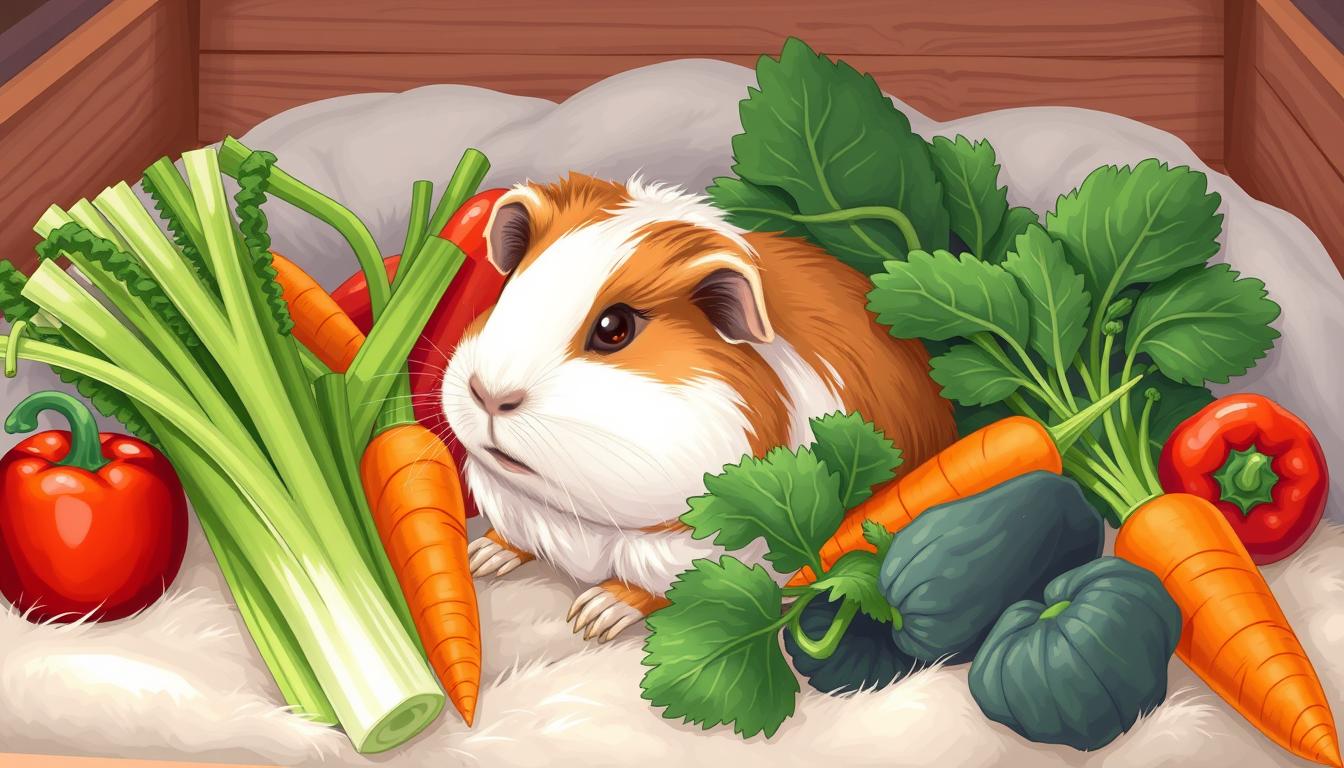As a devoted guinea pig parent, I know how crucial it is to give your furry friend a balanced diet. Celery is a vegetable that often sparks questions. Can guinea pigs safely enjoy this crunchy, refreshing treat? The answer is a big yes! Celery can be a great addition to your guinea pig’s diet, offering important vitamins, minerals, and fiber. But, it’s important to know how to add celery to their diet safely.
In this guide, we’ll look at celery’s nutritional benefits. We’ll also share safe ways to prepare and serve it. And, we’ll talk about any risks or precautions you should remember.
Table of Contents
Understanding Guinea Pig Nutrition Basics
As caretakers of these delightful cavy companions, it’s crucial to understand the basics of guinea pig nutrition. These furry friends need a balanced diet with essential nutrients. This keeps them healthy and happy.
Essential Nutrients for Guinea Pigs
Guinea pigs have specific dietary needs for their optimal health. The key nutrients they require include:
- Vitamin C: Essential for immune function, collagen production, and bone health.
- Fiber: Crucial for maintaining a healthy digestive system and preventing dental issues.
- Protein: Necessary for growth, tissue repair, and muscle development.
Daily Dietary Requirements
A balanced diet for guinea pigs should include the following daily components:
- Unlimited access to fresh, high-quality hay, such as timothy or orchard grass.
- One cup of fresh vegetables per guinea pig.
- Approximately two tablespoons of high-quality, vitamin C-fortified guinea pig pellets.
The Importance of a Balanced Diet
Providing a well-rounded diet is essential for maintaining the overall health and well-being of your guinea pig. A balanced diet supports proper dental health, digestive function, and immune system function. It helps prevent common health issues like scurvy, obesity, and respiratory problems.
“A healthy, balanced diet is the foundation for a happy, thriving guinea pig.”
Can Guinea Pigs Eat Celery
Yes, guinea pigs can safely eat celery as part of their diet. Celery is full of vitamins, minerals, and fiber. These are key for their health and happiness.
When giving celery to your guinea pig, make sure to wash it well. This removes harmful pesticides or dirt. Also, don’t overfeed celery because it has a lot of water. Too much can upset their stomachs.
Guinea pigs can have a small 2-inch piece of celery, including leaves, a few times a week. This is about 4 grams a day. It’s the right amount to keep them healthy without upsetting their stomachs.
| Nutrient | Amount per 100g |
|---|---|
| Vitamin C | 3.1 mg |
| Vitamin A | 470 IU |
| Vitamin K | 30 μg |
| Fiber | 1.6 g |
Guinea pigs can also eat other safe veggies like bell peppers, carrots, and cucumbers. This makes sure they get a balanced diet. But, always remember to introduce new foods slowly and in small amounts.
“Feeding a well-balanced diet, including appropriate portions of nutrient-rich vegetables like celery, is essential for maintaining the health and happiness of your guinea pig.”
Nutritional Benefits of Celery for Guinea Pigs
Celery is a great veggie for your guinea pig’s diet. It’s full of vitamins, minerals, and antioxidants. These help keep your furry friend healthy and happy.
Vitamin and Mineral Content
Celery is rich in vitamin C, which is key for guinea pigs. They can’t make it on their own. Vitamin C boosts their immune system and keeps their gums healthy. It also stops scurvy.
Celery also has vitamins K, folate, and potassium. These nutrients are important for your guinea pig’s health.
Fiber and Hydration Benefits
Celery is full of fiber, which is good for your guinea pig’s digestive system. It helps with bowel movements and prevents constipation. The water in celery keeps your guinea pig hydrated. This is good for their organs and prevents dehydration.
Antioxidant Properties
Celery has antioxidants like flavonoids and polyphenols. These help your guinea pig’s immune system and protect their cells. They might also reduce inflammation and improve overall health.
While celery is good for your guinea pig, give it in small amounts. Too much can upset their stomach. Talk to your vet about how much and how often to feed it.
Safe Preparation and Serving Guidelines
When you give guinea pig treats like celery, it’s key to prepare and serve it right. Start by washing the celery well to get rid of harmful pesticides or dirt. Then, cut it into small pieces to avoid choking risks.
Make sure to remove any tough strings that could be dangerous. Give your guinea pig a small piece of celery, about one inch, a few times a week. Always introduce new safe foods for cavies slowly and watch how they react to make sure they like it.
- Thoroughly wash celery to remove pesticides and dirt
- Cut celery into small, bite-sized pieces to prevent choking
- Remove tough strings that could be a hazard
- Serve celery in moderation, 1-inch piece a couple times a week
- Introduce new foods gradually and monitor your guinea pig’s reaction
“Proper preparation and serving guidelines are essential when feeding your guinea pig new foods to ensure their safety and well-being.”
By following these easy steps, you can add guinea pig treats like celery to your cavy’s diet safely. This way, they get to enjoy a variety of healthy foods.
Potential Risks and Precautions
Celery can be good for your guinea pig’s diet, but there are risks. It’s important to prepare and watch your cavy closely. This helps keep them healthy and happy when eating celery.
Choking Hazards
Celery can be a choking hazard for guinea pigs. This is because it’s fibrous and can be hard to chew. Make sure to cut the celery into small pieces before giving it to your guinea pig.
Watch them while they eat to make sure they can chew and swallow without trouble.
Digestive Issues
Celery has a lot of water, which can cause stomach problems if eaten too much. Too much celery can lead to diarrhea, bloating, or discomfort. Start with a little bit and watch how your guinea pig reacts.
If they seem uncomfortable, adjust the amount of celery you give them. This keeps their diet balanced and healthy.
Signs of Adverse Reactions
Some guinea pigs might not like celery and could get sick. Look out for signs like not wanting to eat, being very tired, or skin problems. If you see any of these, stop giving them celery and talk to your vet right away.
Knowing the risks and being careful can help you add celery to your guinea pig’s meals safely. Always talk to your vet if you’re unsure about what to feed your cavy.
How Often and How Much Celery to Feed
When adding celery to your guinea pig’s diet, remember to keep it in moderation. Celery should be seen as an occasional treat, not a main food. It’s best to give a small, one-inch piece of celery 2-3 times a week.
This way, your guinea pig can enjoy celery’s benefits without getting sick from eating too much. It’s important to mix celery with other veggies and their main foods: hay and pellets.
- Celery should make up no more than 10-15% of a guinea pig’s total daily vegetable intake.
- Offer a small, one-inch piece of celery 2-3 times per week as a treat.
- Always provide a variety of fresh, Guinea pig-safe vegetables to ensure a balanced diet.
Following these tips will let you add celery to your guinea pig’s diet safely. A varied and balanced diet is key to keeping your guinea pig happy and healthy.

“Moderation is the key when feeding your guinea pig celery. Offering it as an occasional treat, while focusing on a balanced diet of hay, pellets, and a variety of fresh vegetables, will ensure your furry friend stays healthy and happy.”
Incorporating Celery into a Balanced Diet
As a guinea pig owner, it’s key to give a varied and balanced diet. This ensures your furry friend stays healthy. Celery can be a great addition, but it should be part of a mix of safe veggies.
By mixing celery with other veggies, you create a diet that covers all bases. This way, your guinea pig gets all the nutrients they need.
Combining with Other Vegetables
When adding celery to your guinea pig’s diet, pair it with other veggies like:
- Bell peppers
- Carrots
- Cucumbers
- Spinach
- Tomatoes
This mix gives your guinea pig a broad range of vitamins, minerals, and fiber. Remember, hay should be the main part of their diet, making up 85-90% of what they eat.
Weekly Meal Planning
To keep a balanced guinea pig nutrition routine, plan meals for the week. Include celery and other safe veggies. This way, you avoid boredom and ensure a varied diet.
Having a cavy feeding guide that includes celery and other veggies, along with hay and pellets, is best. It supports your guinea pig’s health and happiness.
Safe Alternative Vegetables for Guinea Pigs
Your cavies can enjoy many vegetables for cavies besides celery. Good choices include romaine lettuce, kale, bell peppers, carrots, cucumber, and fresh herbs like parsley and cilantro. Always add new guinea pig treats slowly and in small amounts to watch how they react.
Stay away from veggies that can cause gas, like cabbage and broccoli. Feed them only sometimes to avoid upsetting your guinea pig’s stomach. By giving them a variety of veggies, you help them get important vitamins, minerals, and fiber. This keeps them healthy and happy.
- Romaine lettuce: Packed with vitamins A and C, as well as fiber.
- Kale: A superfood rich in vitamins K, A, and C, plus calcium and iron.
- Bell peppers: Vibrant source of vitamins C, A, and antioxidants.
- Carrots: High in vitamin A and beta-carotene for eye and skin health.
- Cucumber: Provides hydration and vitamins B and K.
- Parsley and cilantro: Nutrient-dense herbs with anti-inflammatory properties.
It’s important to introduce new vegetables for cavies slowly and watch how they react. This helps you find the best guinea pig treats for their needs and likes.

The Role of Hay and Pellets
Keeping your guinea pig diet healthy is key for their happiness. Hay is at the center of their diet, making up most of what they eat.
Hay is vital for guinea pigs. It gives them the fiber they need for a healthy gut. It also helps their teeth grow. Make sure they always have Timothy hay or other grass hays to eat.
Guinea pigs also need pellets, but only a little bit. Give them about 1/8 cup or 2 tablespoons a day. These pellets should have extra vitamin C, which is good for them.
| Dietary Component | Recommended Proportion |
|---|---|
| Hay | 80-85% |
| Pellets | 5-10% |
| Vegetables and Fruits | 15-20% |
Following this diet helps your guinea pig stay healthy. But, don’t overdo it with pellets and treats. Too much can harm their health.
“Hay is the most crucial component of a guinea pig’s diet, providing essential fiber for digestive health and helping to wear down their continuously growing teeth.”
Best Practices for Feeding Fresh Vegetables
Keeping your guinea pig’s diet balanced is key to their health. Hay and pellets are the base, but veggies add important vitamins, minerals, and fiber. To make sure your guinea pig benefits, follow these storage, preparation, and feeding tips.
Storage Tips
Storing veggies right keeps them fresh and nutritious. Wrap them in a damp paper towel and keep them in the fridge. This way, they stay crisp and tasty for days. Don’t leave them out, as they spoil quickly.
Preparation Methods
Wash veggies well to remove dirt and pesticides. Cut them into small pieces for easy chewing and digestion. Make sure they’re not too big to avoid choking hazards.
Feeding Schedule
Stick to a regular feeding time for veggies. This makes mealtime a pleasant routine for your guinea pig. Remove any leftovers after a few hours to keep things clean and healthy.
Start with small amounts of new veggies to avoid upsetting their stomach. By following these tips, you’ll help your guinea pig stay healthy and happy.
Fresh veggies are a great addition to your guinea pig’s diet. Proper storage, preparation, and serving ensure they get the most benefits. This way, your furry friend can enjoy their meals fully.
Conclusion
Adding celery to your guinea pig’s diet can be good. It gives them important nutrients and keeps them hydrated. But, it’s important to only give them a little bit. Make sure their diet is mostly hay and other veggies.
Watch how your guinea pig reacts to celery. If you’re worried, talk to a vet. They can help with their diet and health.
Knowing what’s in celery and how to feed it is key. This way, you can add it to their meals safely. A varied diet keeps your guinea pig happy and healthy for a long time.
Your guinea pig’s health and happiness are most important. Keep learning and talking to experts about their food. With the right food, your guinea pig will be happy and healthy.


1 thought on “Can Guinea Pigs Eat Celery: A Complete Guide”